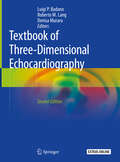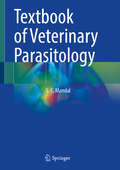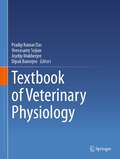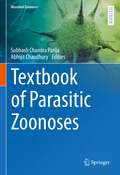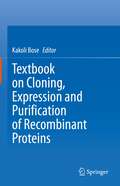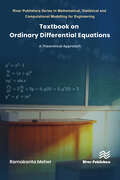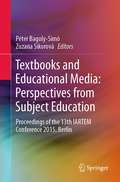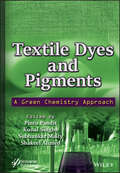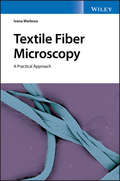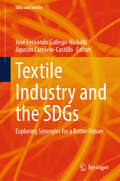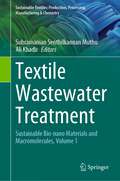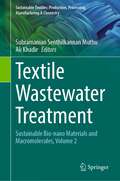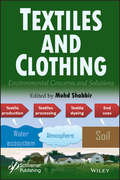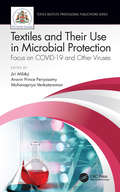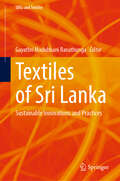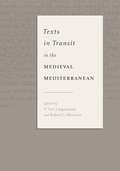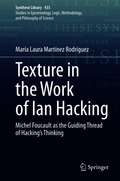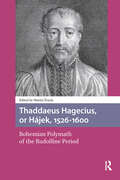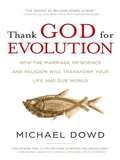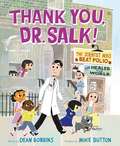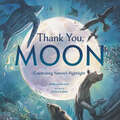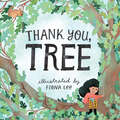- Table View
- List View
Textbook of Three-Dimensional Echocardiography
by Roberto M. Lang Luigi P. Badano Denisa MuraruThis thoroughly revised textbook provides a practically applicable guide to three-dimensional echocardiography (3DE). Background is provided on the evolution of the technology and physics that support the implementation of both transthoracic and transesophageal approaches to 3DE. The incremental value of 3DE to assess cardiac chambers is also described. Moreover, a range of cardiac valvular diseases including the mitral, aortic, and tricuspid valve have been portrayed and illustrated in depth.These include congenital abnormalities, regurgitation and stenosis. Emphasis is also placed on technical aspects of the technique and where it can provide added value, including post-surgery assessments and evaluation of cardiac masses.Textbook of Three-Dimensional Echocardiography enables readers to develop a deep understanding of how to use this imaging modality. It provides a valuable resource for the echocardiography trainee looking to develop their knowledge and for the experienced practitioner seeking a comprehensive up-to-date reference.
Textbook of Veterinary Parasitology
by S. C. MandalThis textbook for graduate students imparts knowledge on parasites of veterinary significance. It provides a basic understanding of taxonomy, morphology, life cycle, pathogenesis, diagnosis, treatment, and control strategies against important helminthic, protozoan and arthropod parasites of animals. The book also presents the useful information on the host-parasite interactions, host response, immune regulation, the impact of nutrition on the host immunity, and immune evasion by the parasite. This textbook is an essential reference for veterinary graduates, providing up-to-date resources on diagnosis, treatment, and controlling essential parasites of animals.
Textbook of Veterinary Physiology
by Veerasamy Sejian Pradip Kumar Das Joydip Mukherjee Dipak BanerjeeThis textbook explores the fundamental qualitative and quantitative aspects of veterinary physiology. It presents the morphological description of the organs, tissues, and cells involved in the physiological system with species variation. The book provide the most up-to-date information and in depth knowledge in animal physiology. The book addresses a broad range of topics, including the physiology of digestion in, monogastric animals, ruminants, and birds, and cardio vascular and respiratory system in different animals. The chapters contain a wealth of information on the areas related to the endocrine system, excretory system, body fluid homeostasis, hematology, male and female reproductive systems, coordination of body functions, and regulation of brain functions and sense organs. Further, this book acquaints students with advanced topics like immune system, assisted reproductive technology, ovarian dynamics, environmental physiology and thermoregulation, and behavioral physiology. This textbook contains clear illustrations including graphical abstracts and study questions for each chaptermaking this book a valuable learning resource for veterinary sciences and veterinary medicine students.Further to attract students and create interest in them, interesting facts related to animal physiology have also been highlighted in form of “Know more widges”.
Textbook of parasitic zoonoses (Microbial Zoonoses)
by Subhash Chandra Parija Abhijit ChaudhuryThis textbook, which is the first volume in the series Microbial Zoonoses, provides a comprehensive overview of the diagnosis, treatment and control of zoonotic parasitic diseases. The book is divided into two sections; the first section discusses the classification of parasitic zoonoses and includes general information on the diagnosis, treatment, epidemiology, prevention, and control of parasitic zoonoses. It also describes the biological features of these organisms, host-parasite interactions, and the disease spectrum, as well as the importance of public health control measures, such as surveillance, and prophylactic measures in controlling these diseases.The second section explores the important zoonotic diseases caused by ectoparasites, protozoan and helminths parasites. It also reviews the life cycle, pathogenesis, pathology, immunology and clinical manifestations, modern diagnostic methods, treatment regimen, prevention, control, and epidemiology of these parasites.Cutting across the disciplines, this book serves as a guide to postgraduate students, faculty members, public health experts, and medical administrators who are interested in the management of these parasitic zoonotic infections.
Textbook on Cloning, Expression and Purification of Recombinant Proteins
by Kakoli BoseThis book is immensely useful for graduate students as well as researchers to understand the basics of molecular biology and Recombinant DNA Technology. It provides a comprehensive overview of different approaches for the synthesis of recombinant proteins from E. coli including their cloning, expression and purification. Recent advances in genomics, proteomics, and bioinformatics have facilitated the use of Recombinant DNA Technology for evaluating the biophysical and biochemical properties of various proteins. The book starts with an introductory chapter on gene cloning, protein expression and purification and its implication in current research and commercial applications. Each chapter provides a lucid set of principles, tools and techniques for both students and instructors. The protocols described have been aptly exemplified, and troubleshooting techniques have been included to aid better understanding. Moreover, the set of questions at the end of each chapter have been particularly formulated to help effective learning.
Textbook on Ordinary Differential Equations: A Theoretical Approach
by Ramakanta MeherMany scientific and real-world problems that occur in science, engineering, and medicine can be represented in differential equations. There is a vital role for differential equations in studying the behavior of different types of real-world problems. Thus, it becomes crucial to know the existence and uniqueness properties of differential equations and various methods of finding differential equation solutions in explicit form. It is also essential to know different kinds of differential equations in terms of eigenvalues, termed eigenvalue problems, and some special functions used in finding the solution to differential equations. The study of nonlinear problems also plays a significant role in different real-world situations. There is a necessity to know the behavior of solutions of nonlinear differential equations. Still, there are very few forms of differential equations whose solution can be found in explicit form. For the differential equations whose solutions cannot be found in explicit form, one has to study the properties of solutions of the given differential equation to guess an approximate solution of it. This book aims to introduce all the necessary topics of differential equations in one book so that laymen can easily understand the subject and apply it in their research areas. The novel approach used in this book is the introduction of different analytical methods for finding the solution of differential equations with sufficient theorems, corollaries, and examples, and the geometrical interpretations in each topic. This textbook is intended to study the theory and methods of finding the explicit solutions to differential equations, wherever possible, and in the absence of finding explicit solutions, it is intended to study the properties of solutions to the given differential equations. This book is based on syllabi of the theory of differential equations prescribed for postgraduate students of mathematics and applied mathematics in different institutions and universities of India and abroad. This book will be helpful for competitive examinations as well.
Textbook on Spherical Astronomy
by R. M. Green W. M. SmartThis well-established textbook gives a general but comprehensive introduction to positional astronomy. Originally based on the author's lecture courses at Cambridge University, it is intended primarily for undergraduates, but, due to its comprehensive nature, it is a very useful reference text for research workers in many branches of astronomy and space physics. The author considers the night sky as the celestial sphere and powerfully exploits the methods of spherical geometry. Most problems in which the precise determination of a heavenly body's position in the sky is important are considered in theoretical detail, and the necessary formulae are derived to a precision that is sufficient for all but the most specialist purposes. The present revision has ensured that the terminology and treatment correspond precisely to current astronomical practice. A guiding principle has been to re-establish compatibility with the Astronomical Ephemeris and, to a lesser extent, with the fuller explanations of the Explanatory Supplement to the Astronomical Ephemeris and the American Ephemeris and Nautical Almanac. Fairly frequent comments added to the text indicate the sometimes modified relevance of the subject matter to modern astronomy. A number of additional exercises help to illustrate the new material.
Textbooks and Educational Media: Proceedings of the 13th IARTEM Conference 2015, Berlin
by Péter Bagoly-Simó Zuzana SikorováThis book brings together empirical research and conceptual work on textbooks and education media from 13 countries and 17 disciplines. Along with textbook production, usage, and development, it also explores the interconnectedness of (educational) policy and teaching and learning materials. Further, the book offers insights into regional and local discourses (e.g. specific theories of Portuguese- and Spanish-speaking countries as well as Nordic countries, contrasting their theories with international literature), practices, and solutions with regard to teaching selected subjects at the pre-primary, primary, secondary, and tertiary level. This book also discusses the specific combinations of subjects (e.g. Physics, Biology, Geography, Swedish, English) and their subject-specific education (e.g. Physics Education or Didactics). Lastly, it examines the work of a number of early-career researchers, giving them a voice and bringing in fresh ideas currently being developed in various countries around the globe.This proceedings volume will appeal to publishers, subject educators in primary, secondary, and tertiary education, and academic researchers from the fields of textbooks, educational media and subject-specific education. Its international authorship and explicit focus on subject-specific particularities of educational media provide a unique and comprehensive overview.
Textile Dyes and Pigments: A Green Chemistry Approach
by Shakeel Ahmed Pintu Pandit Kunal Singha Subhankar MaityTextile Dyes and Pigments The book covers the best possible innovation and advancement in dyes and pigments for application in textile materials. Green chemistry can be applied across the life cycle of a chemical-intensive product, including its design, manufacture, use, and ultimate disposal. Innovations to green approaches are required either by developing a whole new set of eco-friendly dyes and pigments or by developing and designing unique dyeing methods. Textile Dyes and Pigments: A Green Chemistry Approach is a response to the many industries currently using conventional textile dyeing and pigmentation methods that are looking for sustainable green chemical options. It describes the various organic and inorganic color pigments and recent developments in vat, reactive, disperse, acid, and azo dyes and their importance in the field of green chemistry. It also covers the various challenges, opportunities, approaches, techniques, marketing, and alternative procedures/sustainable routes involved in developing textile dyes and pigments with green practices. Moreover, the book addresses the structure, process, and the nitty-gritty of modern dyes and pigments in the textile and garment sectors. Audience The book will be of prime interest to researchers and industry manufacturers and engineers in dyes, pigments, textile processing technology, fiber technology, and textile chemistry. It will also be an invaluable reference guide to new scholars and industry personnel who wish to learn about green dyes and pigments and their relevant application processes.
Textile Fiber Microscopy: A Practical Approach
by Ivana MarkovaA groundbreaking text to the study of textile fibers that bridges the knowledge gap between fiber shape and end uses Textile Fiber Microscopy offers an important and comprehensive guide to the study of textile fibers and contains a unique text that prioritizes a review of fibers’ microstructure, macrostructure and chemical composition. The author – a noted expert in the field – details many fiber types and includes all the possible fiber shapes with a number of illustrative micrographs. The author explores a wealth of topics such as fiber end uses, fiber source and production, a history of each fiber and the sustainability of the various fibers. The text includes a review of environmentally friendly fibers and contains information on the most current fiber science by putting the focus on fibers that have been mechanically or chemically recycled, for use in textile production. The author also offers an exploration of issues of textile waste and the lack of textile recycling that can help public policymakers with ways to inform and regulate post-industrial and post-consumer textile waste issues. This vital guide: Contains an accompanied micrograph for many fibers presented Includes information on how fiber microstructure is connected to fabric properties and how it affects the end use of fabrics Offers a review of the sophistication of textile fibers from a scientific point of view Presents a comparative textile fiber review that is appropriate for both for students, textile experts and forensic scientists Written for students and professionals of apparel design and merchandising, and forensic scientists, Textile Fiber Microscopy presents an important review of textile fibers from a unique perspective that explores fibers’ microstructure, macrostructure and chemical composition.
Textile Industry and the SDGs: Exploring Synergies for a Better Future (SDGs and Textiles)
by José Fernando Gallego-Nicholls Agustín Carrilero-CastilloThis book offers an exploration of the textile industry and their relationship to the Sustainable Development Goals (SDGs), catering specifically to academic researchers and providing a roadmap for aligning aligning textile research with the SDGs. It covers a wide range of topics, starting with an overview of the SDGs and their relevance to the textile industry. It examines the environmental footprint of textiles, including issues related to raw material sourcing, manufacturing processes, and waste management. Additionally, it explores the social and economic aspects of textiles, such as labor conditions, fair trade, and responsible consumption. One of the main focuses of this book is the role of innovation and technology in advancing sustainable textiles. It discusses emerging materials and technologies that promote circularity, reduce environmental harm, and enhance social well-being. Furthermore, it explores the potential of digitalization, artificial intelligence, and data analytics in optimizing textile production, distribution, and consumption patterns. This book also addresses the challenges and opportunities associated with sustainable textile supply chains. It analyzes the complexities of global value chains, the need for transparency and traceability, and the importance of collaboration among stakeholders. Furthermore, it highlights strategies for promoting sustainable fashion, encouraging responsible consumption, and fostering circular business models. By delving into these topics, this book aims to solve several key problems faced by academic researchers in the field of textiles and sustainability. It provides a holistic understanding of the SDGs and their integration into textile research, helping researchers align their work with broader sustainability objectives. It offers insights into the latest innovations and technologies, enabling researchers to explore cutting-edge solutions for sustainable textiles. Additionally, it presents case studies and best practices from industry leaders, inspiring researchers to undertake impactful research and contribute to positive change. This book is intended for academic researchers, as well as practitioners, specializing in textiles, sustainability, and related fields. It serves as a valuable resource for professors, postgraduate students, and professionals seeking to deepen their knowledge of the interplay between textiles and the SDGs. It encourages critical thinking, fosters interdisciplinary collaboration, and equips researchers with the tools and insights necessary to drive sustainable transformations within the textile industry and beyond.
Textile Wastewater Treatment: Sustainable Bio-nano Materials and Macromolecules, Volume 1 (Sustainable Textiles: Production, Processing, Manufacturing & Chemistry)
by Subramanian Senthilkannan Muthu Ali KhadirIn this first volume, various materials such as chitosan, lignin-based biomaterials, cellulosic based bio materials, carbon materials, Polysaccharide-composites materials, Aromatic-Based Synthetic Macromolecules, Agricultural wastes, etc for treating textile waste water are highlighted. One of the major pollutants in the textile and fashion industry is (textile) waste water. Textile wastewater can lead to serious environmental issues if discharged without proper and sufficient treatment. The materials employed along with the technologies available to trate waste water are the key. There are a lot of advancements in terms materials, technologies employed for textile waste water treatment. Sustainable bio-nano materials and macro molecules play a major role in the efficient treatment of textile waster.
Textile Wastewater Treatment: Sustainable Bio-nano Materials and Macromolecules, Volume 2 (Sustainable Textiles: Production, Processing, Manufacturing & Chemistry)
by Subramanian Senthilkannan Muthu Ali KhadirIn this second volume, various materials such as Magnetic-based biocomposites, wheat bran/straw-based biomaterials, peel-based biomaterials, luffa Based Biomaterials, composite polymeric membranes, rice husk, hydroxyapatite etc for treating textile waste water are highlighted. One of the major pollutants in the textiles and fashion sector is textile waste water. Textile wastewater can lead to serious environmental issues if discharged without proper and sufficient treatment. The materials employed along with the technologies available to trate the waste water are the key. There are a lot of advancements in terms materials, technologies employed for textile waste water treatment. Sustainable bio-nano materials and macro molecules play a major role in the efficient textile waste treatment.
Textiles and Clothing: Environmental Concerns and Solutions
by Mohd ShabbirGreater emphasis needs to be placed on research into eco-friendly processes particularly suited for the textile industry. With this goal in mind, all environmental aspects relating to the textile and clothing industry are discussed in this book. Included in the 11 informative chapters herein are topics covering the correlation between the environment and the processing and utilization of textiles and clothing. Chapter 1 discusses the direct impact that the textile industry has on the environment. The hazardous environmental consequences that synthetic dyes used to color textiles have on the environment are highlighted in Chapter 2. Greener alternatives to dyeing are discussed in Chapters 3 through 5, and eco-friendly ways of finishing textiles are discussed in Chapters 6 and 7. Finally, solutions to address the environmental hazards associated with the textile industry are presented in Chapters 8 through 11.
Textiles and Their Use in Microbial Protection: Focus on COVID-19 and Other Viruses (Textile Institute Professional Publications)
by Aravin Prince Periyasamy Mohanapriya Venkataraman Jiri MilitkýTextiles and Their Use in Microbial Protection: Focus on COVID-19 and Other Viruses provides readers with vital information about disinfection mechanisms used in textile applications in the fight against dangerous microbes and viruses. KEY FEATURES: Introduces the basics of textile materials used for medical applications Features key information on virology, characterization, indication, and passivation of COVID-19 Describes UV, photocatalysis, photooxidation, application of TiO2, copper-based viral inhibition, and activated carbon Discusses antiviral finishes for the protection against SARS-CoV-2, particle penetration in dense cotton fabrics under swollen state, and the impact of moisture on face masks and their designs Aimed at textile and materials engineers as well as readers in medical fields, this text offers a comprehensive view of fundamentals and solutions in the use of textiles for microbial protection.
Textiles of Sri Lanka: Sustainable Innovations and Practices (SDGs and Textiles)
by Gayathri Madubhani RanathungaThis book highlights the role of sustainable development in ancient practices to modern innovations in the textiles of Sri Lanka. It reveals the textile of Sri Lanka from the historical age to current tech-fabrics. Supporting the sustainable development goals, this book covers the most sought-after concepts and practices in textile industry of Sri Lanka such as of maximum utilization, zero waste, eco-friendly production process, reuse, upcycling, recycling, and longevity. Various topics covered in this book are indigenous cultural textiles, women empowerment, agro-waste utilization, secondhand-fashion consumption, and many more. The book is a valuable reference for beginners, university students, researchers, and professionals interested in sustainable development in textiles and allied fields.
Texts in Transit in the Medieval Mediterranean
by Y. Tzvi Langermann Robert G. MorrisonThis collection of essays studies the movement of texts in the Mediterranean basin in the medieval period from historical and philological perspectives. Rejecting the presumption that texts simply travel without changing, the contributors examine closely the nature of these writings, which are concerned with such topics as science and medicine, and how they changed over the course of their journeys. Transit and transformation give texts new subtexts and contexts, providing windows through which to study how memory, encryption, oral communication, cultural and religious values, and knowledge traveled and were shared, transformed, and preserved. This volume broadens how we think about texts, communication, and knowledge in the medieval world.Aside from the editors, the contributors are Mushegh Asatryan, Brian N. Becker, Leonardo Capezzone, Leigh Chipman, Ofer Elior, Zohar Hadromi-Allouche, B. Harun Küçük, Israel M. Sandman, and Tamás Visi.
Texts in Transit in the Medieval Mediterranean
by Y. Tzvi Langermann, Robert G. MorrisonThis collection of essays studies the movement of texts in the Mediterranean basin in the medieval period from historical and philological perspectives. Rejecting the presumption that texts simply travel without changing, the contributors examine closely the nature of these writings, which are concerned with such topics as science and medicine, and how they changed over the course of their journeys. Transit and transformation give texts new subtexts and contexts, providing windows through which to study how memory, encryption, oral communication, cultural and religious values, and knowledge traveled and were shared, transformed, and preserved. This volume broadens how we think about texts, communication, and knowledge in the medieval world.Aside from the editors, the contributors are Mushegh Asatryan, Brian N. Becker, Leonardo Capezzone, Leigh Chipman, Ofer Elior, Zohar Hadromi-Allouche, B. Harun Küçük, Israel M. Sandman, and Tamás Visi.
Texture in the Work of Ian Hacking: Michel Foucault as the Guiding Thread of Hacking’s Thinking (Synthese Library #435)
by María Laura Martínez RodríguezThis book offers a systematized overview of Ian Hacking's work. It presents Hacking’s oeuvre as a network made up of four interconnected key nodes: styles of scientific thinking & doing, probability, making up people, and experimentation and scientific realism.Its central claim is that Michel Foucault’s influence is the underlying thread that runs across the Canadian philosopher’s oeuvre. Foucault’s imprint on Hacking’s work is usually mentioned in relation to styles of scientific reasoning and the human sciences. This research shows that Foucault’s influence can in fact be extended beyond these fields, insofar the underlying interest to the whole corpus of Hacking’s works, namely the analysis of conditions of possibility, is stimulated by the work of the French philosopher.Displacing scientific realism as the central focus of Ian Hacking’s oeuvre opens up a very different landscape, showing, behind the apparent dispersion of his works, the far-reaching interest that amalgamates them: to reveal the historical and situated conditions of possibility for the emergence of scientific objects and concepts.This book shows how Hacking’s deployment concepts such as looping effect, making up people, and interactive kinds, can complement Foucauldian analyses, offering an overarching perspective that can provide a better explanation of the objects of the human sciences and their behaviors.
Thaddaeus Hagecius, or Hájek, 1526-1600: Bohemian Polymath of the Rudolfine Period (Scientiae Studies)
by Martin ŽemlaTadeas Hajek of Hajek (1526–1600), Latinized as Thaddaeus Hagecius ab Hagek/Hayek, was a key figure in early scientific debates not only in his native Bohemia. A versatile scholar and polymath, he was prolific in medicine, botany, mathematics and astronomy. Modern interpreters tended to point out his astronomical interpretations to emphasize his greatest achievements and his “modernity.” However, Hajek also drew extensively on traditional arts such as alchemy, astrology and metoposcopy. In this volume, the contributors study various aspects of Hayek’s thought to present a less tendentious intellectual portrait of him in the context of his times. Even from this more adequate perspective, he remains an important figure in the dialectical process of transmitting ideas whose influence extended far beyond the Czech lands.
Thank God for Evolution: How the Marriage of Science and Religion Will Transform Your Life and Our World
by Michael DowdFew issues have revealed deeper divisions in our society than the debate between creationism and evolution, between religion and science. Yet from the fray, Reverend Michael Dowd has emerged as a reconciler, finding faith strengthened by the power of reason. With evidence from contemporary astrophysics, geology, biology, anthropology, and evolutionary psychology, Thank God for Evolution lays out a compelling argument for how religion and science can be mutually enriching forces in our lives. Praised by Nobel laureates in the scientific community and religious leaders alike, Thank God for Evolution will expand the horizon of what is possible for self, for relationships, and for our world.
Thank You, Dr. Salk!: The Scientist Who Beat Polio and Healed the World
by Dean RobbinsDr. Jonas Salk finds the cure for polio in this inspiring, educational, and timely nonfiction picture book.Jonas Salk wasn't seen as a brave hero—not at first. As a child he was quiet and unassuming, but Jonas dreamed of tikkun olam, the Jewish phrase for “healing the world.” He saw the polio virus strike his city, and he knew that with determination and hard work, he could be the one to stop its spread. So he grew up to study medicine, ultimately creating the polio vaccine that saved untold numbers of lives—and healed the world!With Dean Robbins’s inspiring text and Mike Dutton’s dynamic illustrations, Thank You, Dr. Salk! is a true and timely story of trials, triumph, and what it takes to achieve your dreams. An author’s note provides additional insight into Dr. Salk’s life and influences, and the history of vaccines.
Thank You, Moon: Celebrating Nature's Nightlight
by Melissa StewartWith the soothing rhythm of a bedtime story and the scientific wonder of a nature doc, comes a celebration of the moon and all the creatures who rely on its light to find their way home.Under the glow of a shimmering moon, creatures great and small creep out of their dens, using its light to hunt, fend off predators, build their nests or build families. As the moon changes phases these animals adapt their behavior to match its waxing and waning—while human animals look on in wonder.As Earth's closest companion in space, the moon has fascinated humankind for generations, and this nonfiction picture book sheds light on the mysterious ways it affects life on Earth. With luminous illustrations by Jessica Lanan and a lyrical text that is part lullaby and part scientific resource, Thank You, Moon is a treasure for all ages to enjoy.
Thank You, Tree: A Board Book
by Editors of Storey PublishingOn every page of this beautiful board book, Fiona Lee's charming illustrations invite little ones to celebrate a wonderful tree, learn its name, and say thank you for the tree&’s joyful, natural gifts. From thanking a magnolia tree for its pink blossoms and a birch tree for a branch to swing on to thanking a maple tree for its colorful fall leaves and a cedar for a secret hiding place, this sweet book teaches the youngest readers to celebrates trees for their leaves, branches, flowers, fruits, and more.
That Crazy Eddie and the Science Project of Doom
by Judy CoxBest friends Matt and Eddie have a falling out that threatens to ruin their science fair project. Includes instructions for making a model of an erupting volcano.
